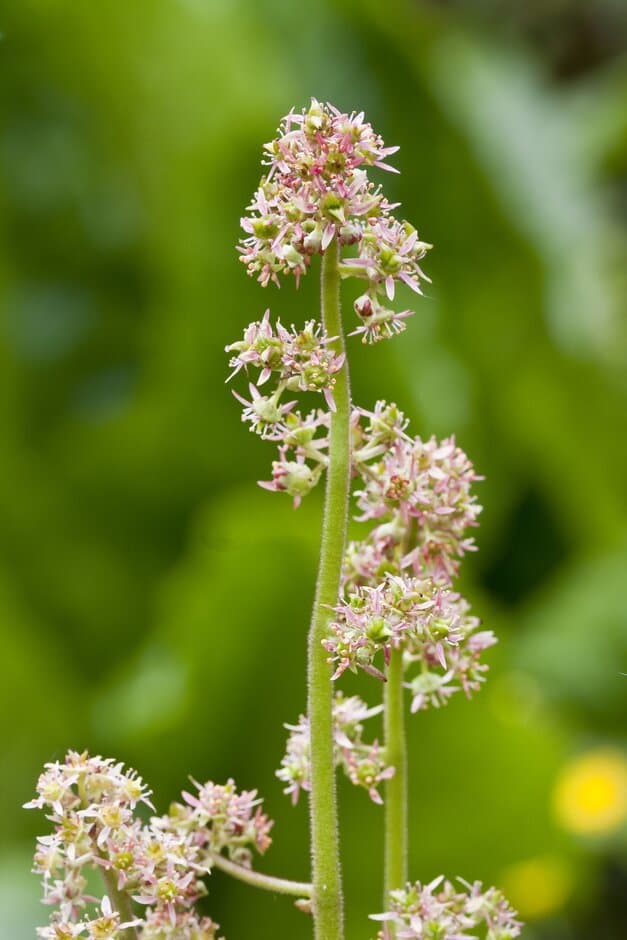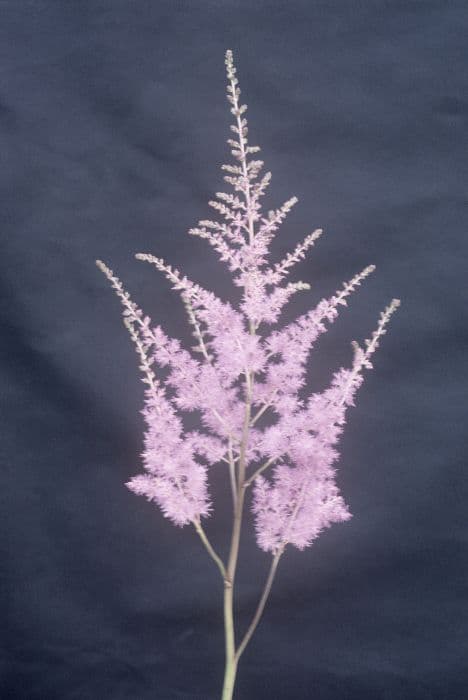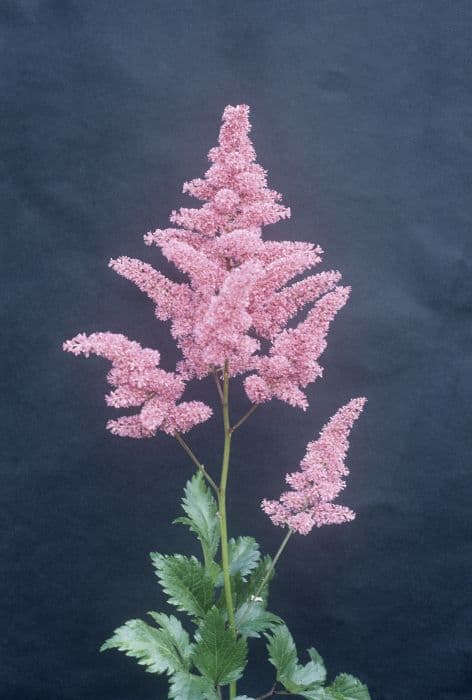Swamp Saxifrage Saxifraga pensylvanica (4)

ABOUT
Saxifraga pensylvanica, also commonly known as the swamp saxifrage, is a perennial flower that presents charming visual characteristics distinct to its species. The plant typically showcases a basal rosette of rich green leaves that are somewhat spoon-shaped with slightly toothed edges, giving it a somewhat rugged yet appealing texture. As the growing season progresses, it sprouts up a flower stalk topped with an array of star-shaped, petite, greenish-white flowers. Each flower possesses its own allure, with a delicate symmetry and small petals that allure pollinators. The leafy base contrasts the light hue of the flowers, making the swamp saxifrage a subtle but attractive plant. Its growth form gives it a lush appearance, as though it's cradling the flowers on its green pedestal. Though found in moist habitats, its overall appearance gives it a vibrant look, symbolizing the lushness and vitality of the environments it thrives in.
About this plant
 Names
NamesFamily
Saxifragaceae
Synonyms
Pennsylvania Saxifrage, Swamp Saxifrage
Common names
Saxifraga michauxii, Micranthes pensylvanica, Saxifraga ligulata, Saxifraga pensylvanica var. cordifolia.
 Toxicity
ToxicityTo humans
The Eastern Swamp Saxifrage is generally not considered toxic to humans. Ingesting any part of this plant is unlikely to cause poisoning or adverse health effects based on commonly available information.
To pets
The Eastern Swamp Saxifrage is also not considered toxic to pets. It poses no known significant risk of poisoning if pets were to ingest any part of the plant, according to commonly available resources on plant toxicity for animals.
 Characteristics
CharacteristicsLife cycle
Perennials
Foliage type
Deciduous
Color of leaves
Green
Flower color
White
Height
1 foot [30 cm]
Spread
1 foot [30 cm]
Plant type
Herb
Hardiness zones
3
Native area
North America
Benefits
 General Benefits
General Benefits- Attracts Wildlife: Saxifraga pensylvanica, also called Swamp Saxifrage, is known to attract butterflies and other beneficial insects, providing essential nectar sources for pollinators.
- Native Plant Gardening: As a native plant to North America, including it in landscaping supports local ecosystems and biodiversity.
- Erosion Control: Swamp Saxifrage has a robust root system, making it an effective plant for stabilizing soil and controlling erosion.
- Low Maintenance: Being a native species, it is well-adapted to local conditions and typically requires less care than non-native ornamental plants.
- Ornamental Value: Adds aesthetic appeal to gardens and naturalistic landscapes with its attractive foliage and spikes of small, star-shaped flowers.
- Wetland Conservation: Ideal for wetland or bog garden settings, it helps in the preservation and restoration of these critical habitats.
- Educational Interest: Can be used as an educational tool to teach about native species, their roles in the ecosystem, and conservation efforts.
 Medical Properties
Medical Properties- This plant is not used for medical purposes.
 Air-purifying Qualities
Air-purifying QualitiesThis plant is not specifically known for air purifying qualities.
 Other Uses
Other Uses- Ground cover: Saxifraga pensylvanica, commonly known as the swamp saxifrage, can be used as a ground cover in damp areas of the garden, providing a lush green carpet.
- Rock gardens: Its clumping habit and tolerance for rocky terrain make it suitable for adding texture and greenery to rock gardens.
- Erosion control: The extensive root system of swamp saxifrage helps in stabilizing soil and controlling erosion on slopes and banks near water bodies.
- Butterfly attraction: Swamp saxifrage can attract butterflies, adding an element of wildlife to the garden.
- Water garden accent: Being native to wetlands, it can be planted as an accent in water gardens or around ponds.
- Education: Swamp saxifrage can be used in educational settings to teach about native plants and their habitats.
- Photography subject: The plant's delicate flowers and striking foliage make it an interesting subject for nature photography.
- Seasonal interest: In certain regions, swamp saxifrage offers early spring flowers adding seasonal interest to the landscape.
- Green roofing: Due to its low-maintenance and hardy nature, it may be suitable for green roofing projects aiming for a native plant palette.
- Biodiversity support: Planting swamp saxifrage supports local biodiversity by providing habitat for native insects and other fauna.
Interesting Facts
 Feng Shui
Feng ShuiThe Swamp Saxifrage is not used in Feng Shui practice.
 Zodiac Sign Compitability
Zodiac Sign CompitabilityThe Swamp Saxifrage is not used in astrology practice.
 Plant Symbolism
Plant Symbolism- Persistence: Saxifraga pensylvanica, commonly known as the swamp saxifrage, often grows in rocky soils, symbolizing the ability to thrive in challenging conditions and representing resilience and determination.
- Adaptability: The swamp saxifrage's natural habitat includes wetlands and marshy areas, which can be harsh environments. This reflects adaptability and the idea that one can survive and bloom wherever they are planted.
- Tenacity: Like many plants that grow in tough environments, the swamp saxifrage is seen as tenacious, symbolizing the strength to hold on and persevere through adversity.
 Water
WaterPennsylvania saxifrage prefers consistently moist soil and should be watered thoroughly whenever the top inch of soil begins to dry out. Typically, this might mean watering with about 1 to 2 gallons per week, depending on climate conditions, soil type, and plant size. During the hotter seasons or in drier climates, the frequency may need to increase to maintain moisture. Conversely, in cooler seasons or wetter climates, watering may be reduced. It's important to avoid overwatering as this can lead to root rot, so ensure the plant has good drainage.
 Light
LightPennsylvania saxifrage thrives in partial shade to full sun. The best spot for this plant would be a location where it can receive morning sunlight and afternoon shade, particularly in areas with hot summers. This ensures that the plant gets enough light without being exposed to the intense heat of the midday sun. Avoid deep shade as it can lead to poor growth and fewer blooms.
 Temperature
TemperaturePennsylvania saxifrage is hardy and can withstand a wide range of temperatures but prefers cooler conditions. It can survive in temperatures as low as 0°F and as high as 80°F, but the ideal temperature range is between 60°F and 70°F. It is well-suited for temperate regions and can tolerate some frost without significant damage.
 Pruning
PruningPennsylvania saxifrage can benefit from pruning to remove any spent flowers or damaged leaves and to maintain plant shape. Pruning should be done after the blooming period, which typically occurs in the spring. Cut back the flower stalks and any unhealthy foliage to encourage new growth. Annual or biennial pruning is usually sufficient, depending on the plant's growth and appearance.
 Cleaning
CleaningAs needed
 Soil
SoilThe Pennsylvania Saxifrage prefers moist, well-draining soil with a rich organic content; a mix of loamy soil, peat, and sand is ideal. The pH should be slightly acidic to neutral, ranging from 5.5 to 7.0 for optimal growth.
 Repotting
RepottingPennsylvania Saxifrage does not typically require frequent repotting, as it grows well in natural conditions. If grown in a container, repotting can be done every 2-3 years or when the plant has outgrown its current pot.
 Humidity & Misting
Humidity & MistingPennsylvania Saxifrage thrives in average to high humidity levels, which mimic its natural boggy and wetland habitats. Ensuring a humidity level that is consistently above 50% will support its growth and health.
 Suitable locations
Suitable locationsIndoor
Provide bright, indirect light and keep the soil moist.
Outdoor
Plant in part shade, keep soil moist and ensure good drainage.
Hardiness zone
3-8 USDA
 Life cycle
Life cycleThe common name for Saxifraga pensylvanica is Swamp Saxifrage. The life cycle of Swamp Saxifrage begins with seed germination, occurring in moist, fertile soil in spring. Following germination, seedlings establish themselves, growing into rosettes of basal leaves. As the plants mature, they develop elongated flower stalks topped with small, greenish-white flowers, typically in late spring to early summer. After pollination by insects, these flowers produce capsule-like fruits containing seeds that are dispersed by wind or water. Swamp Saxifrage completes its life cycle by entering a period of dormancy in the winter, resuming growth with the return of favorable conditions in the spring.
 Propogation
PropogationPropogation time
Spring-Early Summer
Propogation: The common name for Saxifraga pensylvanica is Pennsylvania saxifrage, and the most popular method of propagation for this plant is by seed. The best time to sow Pennsylvania saxifrage seeds is in the fall, directly outdoors in a prepared seedbed. The cold period over winter helps to break the seed dormancy, leading to spring germination. Alternatively, seeds can be sown in the spring, but they may require stratification, which means simulating the natural winter conditions by refrigerating the seeds mixed with moist sand for about 2-4 weeks. Once sown, the seeds should be lightly covered with soil and kept consistently moist until germination occurs. Seedlings can then be thinned and transplanted to their desired location once they are large enough to handle. It's important to avoid letting the soil dry out during the critical germination and early growth stages.









